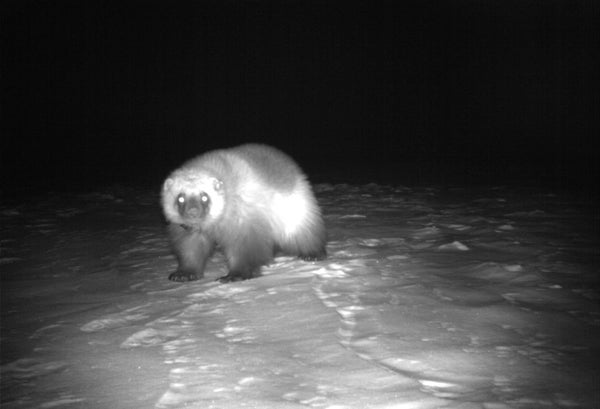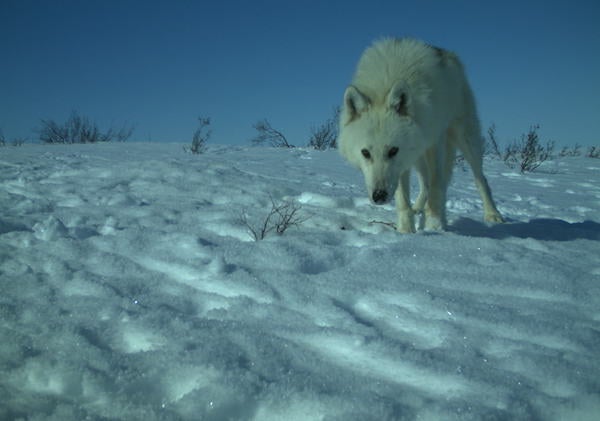This article was published in Scientific American’s former blog network and reflects the views of the author, not necessarily those of Scientific American
I stood up on my snow machine as we approached, back straightened and muscles tensed. One of our satellite-collared wolverines, a young female named Avalanche, had stopped moving 48 hours ago, long enough to warrant investigation. Now, after a cold, hour-long ride from our base camp, we were greeted by a conspicuous mound of black and brown fur. My heart sank.
Our effort is part of a larger Wildlife Conservation Society program in Alaska. We’re combining intensive field studies, cutting-edge wildlife research technology, and the knowledge of indigenous peoples to better understand the ecology of this remarkable species on the harsh Arctic tundra, in habitats that include the Arctic National Wildlife Refuge and the National Petroleum Reserve. Only through such efforts can we learn how to effectively protect these animals, and other iconic wildlife, in these expansive, largely undeveloped places. Ours is the first collar-based research effort on the Arctic tundra since 1981, so our days often bring surprises.
When we arrived at the scene, Avalanche lay on her back, front paws extended, as though frozen mid-bound. A red gash ran across her neck and, transferring her carefully to the back of my snow machine, I could feel that her body was savagely broken. Dense wolf tracks nearby clearly marked her struggle. After five weeks of watching her small red dot move around a map on my computer screen, of visiting the snow dens she slept in, marveling at the caribou she killed, and collecting her scat for analysis, I held back tears.
On supporting science journalism
If you're enjoying this article, consider supporting our award-winning journalism by subscribing. By purchasing a subscription you are helping to ensure the future of impactful stories about the discoveries and ideas shaping our world today.

Avalanche the wolverine at night, captured by a motion-activated camera, in one of the last photographs taken before her death. Credit: Tom Glass WCS
Wolves are a common predator of wolverines, but the relationship is more complicated than simply predator-prey. Across their range, wolverines can be seen tentatively approaching days-old wolf kills, crunching bones and tearing at leftover flesh. They are what is considered a “facultative scavenger”—they eat carrion when it’s available but are quite capable of hunting their own prey when it’s not.
Although it’s difficult to examine interspecific relationships of wide-ranging species such as these in the wild, scientists have learned a lot in the last decade thanks to some innovative studies. Through track-transect surveys, a group at the University of Oulu in Finland found that wolverines prefer areas that are occupied by wolves over those that aren’t. We also know wolves benefit wolverines by creating scavenging opportunities, thanks to a Norwegian group that analyzed wolverine scat both inside and outside of wolf-occupied areas in 2008.
Wolves present a threat to wolverines and the smaller and often more solitary animal must respond accordingly. By placing motion-activated cameras at wolf-killed moose carcasses, a bachelor’s student from Hedmark University College in Norway recently revealed that wolverines are sensitive to the frequency and duration of the wolves’ visits. The wolverines, in fact, moderate their enthusiasm for food (which is legendary, and the root of their Latin name Gulo) in accordance with the risk of being killed.
Much of wolverines’ ability to strike this balance with wolves probably has to do with their sense of timing; get to the carcass after the wolves have left, but before the ravens and foxes have picked it bare.
Here on Alaska’s North Slope, Avalanche’s timing was off. The snow surrounding her body was packed hard with wolf tracks, and the remains of a freshly killed caribou lay 50 feet away. When we had caught her five weeks before, we had interpreted her clean, unchipped teeth and small mammaries as indications of her youth. Perhaps this lesson, of wolves and timing, was one she simply hadn’t learned yet.
As we rode back across the tundra, I thought over the last month of Avalanche’s life, this brief glimpse into a wolverine’s world that we had been offered. Avalanche, like all of our study animals, had used snow holes extensively. During the five weeks she had been collared, she traveled 221 miles, and we visited 20 GPS clusters (locations where she had spent more than 40 minutes). At 19 of these, she had dug down into the snow, possibly to retrieve a cached bone, to find a peaceful place to rest, or to avoid wolves. These sites were typically in deep drifts, and her dens were excavated 10 feet or more into the snowpack, narrow tunnels and small caverns, protected by a hard wind crust.

Motion-activated camera image of a wolf investigating a wolverine's den. Credit: Tom Glass WCS
At several of these sites, wolves visited. We saw them on our motion-activated cameras and we saw their tracks in the snow. At one site, Avalanche sat inside a snow hole adjacent to a cliff while a wolf paced back and forth just below. At another, a wolf paid a midnight visit to a hole that Avalanche had just vacated. We had previously thought that these snow holes were simply resting sites, but at least in the cases when wolves came to visit, they had provided the shelter necessary for her to avoid being killed.
I am awed by wolverines. No bigger than a cocker spaniel, they hunt and kill caribou up to 10 times their size. They may travel 18 to 25 miles in a day on legs only as long as your forearm. One of our study animals traversed Alaska’s North Slope in 11 weeks last spring, effectively traveling the distance from Washington, D.C. to Atlanta.
Though I contest their typical characterization as ferocious and mean, they are undoubtedly endurance machines. They choose some of the most expansive, challenging and beautifully intact natural landscapes on Earth for their homes, and in many ways we are still grasping to understand how their living is made. If there’s any lesson in Avalanche’s story, wolves and snow are surely at its heart.